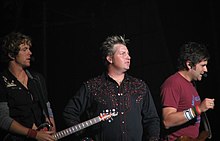Piano Sheets > Rascal Flatts Sheet Music > Bless The Broken Road (ver. 4) Piano Sheet
Bless The Broken Road (ver. 4) by Rascal Flatts - Piano Sheets and Free Sheet Music

About the Song
Other avaliable versions of this music sheet: Version 1 Version 3 Version 4
"Bless the Broken Road" is the title a song that has been recorded by several American country music artists. It was co-written by Marcus Hummon and members of the country music group Nitty Gritty Dirt Band in 1994, and recorded by Hummon a year later. Since then, Melodie Crittenden, Sons of the Desert, Geoff Moore, Selah, Carrie Underwood, and Rascal Flatts have all recorded the song as well. Of the multiple versions that exist, Rascal Flatts' version is the highest-charting, becoming a Number One hit on the Billboard country music charts in 2005 and earning the songwriters a Grammy Award for Best Country Song. Rascal Flatts is an American country rock band founded in Columbus, Ohio. Since its inception, Rascal Flatts has been composed of three members: Gary LeVox (lead vocals), Jay DeMarcus (bass guitar, keyboards, vocals), and Joe Don Rooney (lead guitar, vocals). DeMarcus and LeVox are also.
Download this sheet!
About the Artist

Random article
The essentials of piano sheet music Most people have the notion that sheet music is a very complicated notation and reading it very difficult. However, this is not true as understanding sheet music piano is just a matter of transcribing the various musical notes written.
Uses of sheet music
Piano sheet music is nothing but piano notes written in standard notations. You can avail such free sheet music online from various websites. The main use of sheet music piano is to help aspiring musicians recreate the same sequence of notes as performed by the composer of the piece. It is a method where a specific musical composition is recorded in written form using music notes. The ultimate aim of reading sheet music is to recreate the same score in as accurate a manner as is possible.
(More...)
